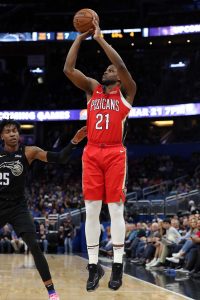Note: This post was updated in February 2020 to reflect the NBA’s latest cap projection for 2020/21.
One of the most lucrative new deals agreed up on this week was a five-year, maximum-salary contract extension for Nuggets guard Jamal Murray. Ben Simmons is expected to soon finalize a similar extension with the Sixers. Those deals were reported as having total values of $170MM apiece, but that number is just an estimate for now.
Because Murray’s new contract won’t go into effect until the 2020/21 season and the NBA won’t finalize the ’20/21 salary cap until the start of next year’s free agency, we can only ballpark what maximum-salary contracts will look like based on the NBA’s latest cap projections.
When the NBA confirmed its salary cap data for the 2019/20 season on June 29, the league also updated its cap estimates for the following two years. The current projection for the 2020/21 cap is $117MM, though that number could fluctuate over the course of the next 12 months or so.
[UPDATE: It has fluctuated multiple times since then — a September projection put the 2020/21 estimate at $116MM, while a January update moved it to $115MM]
For now, we’re basing our maximum-salary estimates on the presumed $115MM cap figure. Listed below are the early maximum-salary projections for 2020/21, based on a $115MM cap. The first chart shows the maximum salaries for a player re-signing with his own team — a player’s previous club can offer five years instead of four, and 8% annual raises instead of 5% raises. The second chart shows the maximum salaries for a player signing with a new team.
A player’s maximum salary is generally determined by his years of NBA experience, so there’s a wide gap between potential earnings for younger and older players. Unless they qualify for a more lucrative extension by meeting certain performance criteria, players with no more than six years of NBA experience are limited to a starting salary worth up to 25% of the cap. For players with seven to nine years of experience, that number is 30%. For players with 10 or more years of experience, it’s 35%.
Here are the the early max-salary projections for 2020/21:
A player re-signing with his own team (8% annual raises, up to five years):
| Year | 6 years or less | 7-9 years | 10+ years |
|---|---|---|---|
| 2020/21 | $28,750,000 | $34,500,000 | $40,250,000 |
| 2021/22 | $31,050,000 | $37,260,000 | $43,470,000 |
| 2022/23 | $33,350,000 | $40,020,000 | $46,690,000 |
| 2023/24 | $35,650,000 | $42,780,000 | $49,910,000 |
| 2024/25 | $37,950,000 | $45,540,000 | $53,130,000 |
| Total | $166,750,000 | $200,100,000 | $233,450,000 |
The “6 years or less” column here is what Murray’s and Simmons’ new extensions would look like, assuming those deals don’t meet certain Rose Rule triggers.
The second column reflects what a player like Anthony Davis could get if he re-signs with his own team as a free agent next summer.
The third column applies not just to players with 10+ years of experience, but also to players who meet the Designated Veteran Extension criteria (Davis would have been eligible for that amount if he had signed an extension with the Pelicans).
A player signing with a new team (5% annual raises, up to four years):
| Year | 6 years or less | 7-9 years | 10+ years |
|---|---|---|---|
| 2020/21 | $28,750,000 | $34,500,000 | $40,250,000 |
| 2021/22 | $30,187,500 | $36,225,000 | $42,262,500 |
| 2022/23 | $31,625,000 | $37,950,000 | $44,275,000 |
| 2023/24 | $33,062,500 | $39,675,000 | $46,287,500 |
| Total | $123,625,000 | $148,350,000 | $173,075,000 |
If a player changes teams as a free agent, he doesn’t have access to a fifth year or 8% raises. So if Murray had opted to sign an offer sheet next summer, he would have been limited to a four-year deal projected to be worth just shy of $124MM.
If Davis or another veteran with between seven and nine years of NBA experience wants to change teams in 2019, he would be limited to a contract worth less than $150MM.
Photo courtesy of USA Today Sports Images.





 Warriors, Nets to swap
Warriors, Nets to swap